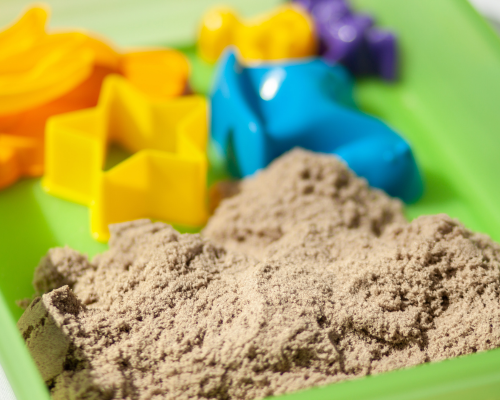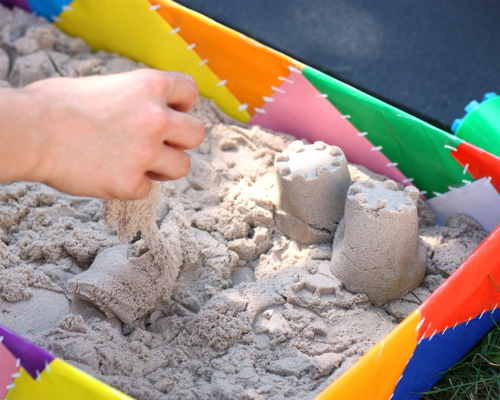My Dog Ate Kinetic Sand What To Do Now?
My Dog Ate Kinetic Sand What To Do Now?

Vet Reviewed

By: Sarah Hodgson
December 12, 2023
- Posted in Dogs
Table of Contents
If you are a dog owner, it's not uncommon to encounter odd situations where your dog gets into something they shouldn't. Now if you have kinetic sand and a dog you might find yourself in one of these odd situations where they are curious and your dog does something they shouldn't.
In this article, we will explore what kinetic sand is, why it can be dangerous for dogs, and what steps you should take if your dog ingests it.
So let's dive in!
Quick Answer
Contact your vet immediately so they can assess the situation. They will most likely induce vomiting. Make sure to not try anything by yourself without any guidance from your vet.
What Is Kinetic Sand?
Kinetic sand is a popular toy sand that provides a unique fun experience for children. It is a type of sand that sticks to itself and can be easily molded into various shapes. Unlike traditional sand, which can be dry and difficult to work with, kinetic sand has a unique texture that makes it feel wet, even though it is not actually wet. It is designed to flow and move almost like a liquid, yet it retains the properties of a solid.
It is made of 98% sand and 2% polymer. The polymer acts as a binding agent, allowing the sand particles to stick together and maintain their shape. Allowing it to stick together and be molded into various shapes.

How is Kinetic Sand Dangerous to Dogs?
While kinetic sand may seem harmless, it can pose serious health risks to dogs if ingested. The silicone oil in the sand can cause gastrointestinal blockages, leading to discomfort, pain, and potentially life-threatening health issues. Besides that the sand itself can cause irritation and inflammation in the digestive tract, further exacerbating the situation.
Kinetic sand is not something you would want your dog near.
Obstruction: The sand can clump together in the dog's stomach or intestines, leading to an obstruction. This can be a serious and potentially life-threatening condition that may require surgical intervention.
Dehydration: Kinetic sand has a unique texture that can absorb moisture. If a dog ingests a large amount of kinetic sand, it may lead to dehydration as the sand absorbs fluids in the digestive system.
Gastrointestinal Upset: Ingesting the polymer component of kinetic sand might lead to gastrointestinal upset, including vomiting and diarrhea.
What To Do If My Dog Ate kinetic Sand
If you discover that your dog has ingested kinetic sand, it's crucial to take immediate action. The longer you wait the worse it can become for them. Here are the steps you should follow:
- Stay calm: It's understandable to feel worried or panicked, but remaining calm will help you think clearly and make informed decisions.
- Assess the situation: Determine how much sand your dog has eaten and if there are any visible signs of distress.
- Contact your veterinarian: Reach out to your vet and provide them with all the necessary information. They will be able to guide you on the next steps based on your dog's size, health, and the amount of sand ingested.
- Follow your vet's advice: Your veterinarian may recommend inducing vomiting or monitoring your dog for any symptoms. It's essential to follow their instructions carefully.
Note
If your dog ingested a small amount of kinetic sand and it's the first time this has happened you should expect diarrhea due to irritation by the sand of his GI tract and the diarrhea should be transient. It will most likely come out in his next bowel movement. Still, it's best to contact your vet.
Immediate Actions to Take if Your Dog Ate Kinetic Sand
In addition to contacting your veterinarian, there are a few immediate actions you can take if your dog has ingested kinetic sand:
- Do not induce vomiting: Unlike some other substances, inducing vomiting may not be recommended for dogs that have ingested kinetic sand. Follow your veterinarian's advice on whether inducing vomiting is necessary in your specific situation.
- Monitor your dog: Keep a close eye on your dog for any abnormal behavior or symptoms. Take note of any changes in appetite, energy levels, or bowel movements.
- Provide water: Offer your dog fresh water to drink. This can help in case the sand is causing any dehydration or discomfort.
- Do not administer any medications: Avoid giving your dog any medications or home remedies without consulting your veterinarian first.
The Symptoms To Look Out For If Dog Ate Kinetic Sand
If your dog has ingested kinetic sand, it's important to monitor them closely for any signs of distress. Some common symptoms to look out for include:
- Vomiting: If your dog starts vomiting, especially if it contains sand or sand particles, it's a clear indication that the sand is causing issues in their digestive system.
- Diarrhea: Loose stools or diarrhea can be a result of the sand irritating the gastrointestinal tract.
- Lethargy: If your dog becomes unusually tired or lacks energy, it could be a sign of discomfort or pain.
- Loss of appetite: A sudden loss of appetite can indicate that your dog is experiencing gastrointestinal distress.
If you notice any of these symptoms or any other concerning behaviors, contact your veterinarian immediately as we mentioned earlier.

Preventing and Keeping Kinetic Sand Out of Reach from Dogs
Prevention is always better than cure, and when it comes to kinetic sand and your dog, it's crucial to take proactive measures, and rather easy to do.
- Store the sand securely: Keep the kinetic sand in a sealed container or bag and store it in a secure location that is out of reach for your dog.
- Supervise playtime: If your children are playing with kinetic sand, make sure they do so in an area where your dog cannot access it. Keep a close eye on both your dog and the sand during playtime.
- Teach "leave it" command: Train your dog to respond to the "leave it" command, so they understand not to touch or ingest anything they shouldn't, including kinetic sand.
- Use baby gates or playpens: If necessary, use baby gates or playpens to create a designated area for your dog where they cannot access the kinetic sand.
By implementing these measures, you can easliy reduce the chances of your dog ingesting kinetic sand and facing potential health risks.
The Bottom Line
So there you have it, if your dog has ingested kinetic sand, it's important to act swiftly and contact your vet. Remember, prevention is key, so take proactive measures to ensure your dog's safety by keeping kinetic sand out of their reach.
Frequently Asked Questions
Is kinetic sand toxic for dogs if ingested?
While the sand itself is generally non-toxic, the polymer component can pose risks if ingested in large quantities. The main concerns are potential gastrointestinal obstruction and upset.
Should I be worried if my dog only ate a small amount of kinetic sand?
While small amounts may not cause immediate harm, it's crucial to monitor your dog for any signs of distress. If you're uncertain about the amount ingested or if your dog is exhibiting symptoms, contact your veterinarian.
Can I induce vomiting at home if my dog ate kinetic sand?
Never induce vomiting without consulting your veterinarian first. In some cases, inducing vomiting may not be recommended, and doing so without professional guidance can lead to further complications.

Subscribe to Petfluence!
Get updates on the latest posts and more from Petfluence straight to your inbox.